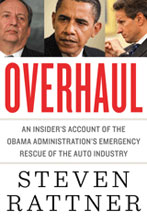The following is a book review of Overhaul: An Insider’s Account of the Obama Administration’s Emergency Rescue of the Auto Industry by Steven Rattner.
Given that General Motors just announced a profitable year and completed the second largest IPO in history, it’s a good time to take stock of the government-engineered restructuring of both GM and Chrysler that the Obama administration began working on even before taking office.
And Steven Rattner is a good guide to how that relatively soft landing was engineered: From February through July of 2009, he directed the Presidential Task Force on the Auto Industry. In Rattner’s parlance, he was head of Team Auto; to the general public, he was Obama’s Car Czar. In a few short months, Rattner and his team shepherded Chrysler and GM through streamlined restructuring under Section 363 of the bankruptcy code, keeping the useful assets, shedding those that had become burdensome and, in Chrysler’s case, picking up a “senior partner” in an alliance with Fiat.
Overhaul: An Insider’s Account of the Obama Administration’s Emergency Rescue of the Auto Industry, Rattner’s recently published account of the auto bailout, benefits not only from Rattner’s position on the inside but also from his particular work history: He came to the Obama administration from Wall Street, where he started at Morgan Stanley and ended up as one of the four founding partners of the private equity firm Quadrangle Group. But he also worked at The New York Times where he was a reporter, first in Washington then in London. His experience shows in Overhaul.
Rattner gives us the data we need to make sense of the bailout, and provides the detail and background information necessary for us to grasp the industrial and economic landscape that shaped it. More importantly, he gives us the story, letting us in on the personalities, the history and also the histrionics.
But Rattner’s own particular story doesn’t end with this book. Since resigning as head of “Team Auto” in July of 2009, he has been dogged by an ongoing investigation of Quadrangle’s involvement in “pay to play” bribery schemes related to New York State pension funds. Quadrangle, with which Rattner is no longer associated, settled its involvement for $12 million in April.
That hasn’t been the end of it, however. Last week, on the day of GM’s IPO, Rattner settled his problems with the Securities and Exchange Commission by accepting a two-year securities trading ban and paying — without admission of guilt – -a $6.2 million fine. Almost simultaneously, New York State Attorney General/governor-elect Andrew Cuomo filed civil fraud charges against Rattner, seeking $26 million in damages and a lifetime ban from the state securities industry. On the following day, Rattner filed an arbitration claim against his former partners at Quadrangle seeking damages for “unlawful conduct and contractual breaches.”
Decline or Resurrection?
Concern about the business practices and competitive position of the U.S. auto industry is not a new phenomenon; people have been writing books on the topic for almost half a century.
In 1965, with the industry in general and General Motors in particular riding a wave of post-war global dominance, a then-unknown young attorney named Ralph Nader published a book entitled Unsafe at Any Speed, a comprehensive indictment of the auto companies’ business practices — particularly those regarding safety issues. Nader pointed to steering columns that acted as spears in head-on collisions, automatic transmissions that were idiosyncratically designed and had a tendency to slip into reverse at inopportune moments, and dashboards constructed of needlessly hard and sharp materials.
The response of GM can only be called Nixonian: The company initiated a campaign of harassment, put Nader under surveillance, eavesdropped on his conversations and tapped his phone. In 1970, GM paid Nader $425,000 to settle the invasion of privacy suit that resulted. Part of that money went to found the Center for Auto Safety.
Some 20 years later, in 1986, with anxiety rampant in the U.S. about the rising market share of Japanese automobiles, Pulitzer Prize winning journalist David Halberstam published The Reckoning. Just shy of 800 pages, the book meticulously tracked the parallel development of the Ford and Nissan motor corporations. Riding high now — the only one of the Detroit Three that didn’t need a government bailout — Ford was at a low ebb then: The joke in Michigan at the time was that the name was actually an acronym for Found On the Road Dead.
Rattner’s book, 24 years after Halberstam’s, feels like a coda, the end of a three book arc. Whether the U.S. auto industry will emerge stronger from the blast furnace of a streamlined bankruptcy process — shorn of insurmountable debts, an excess of both production facilities and dealerships, and burdensome labor contracts — is an open question. Economic and industrial success (or failure) is the product of a complicated, and difficult to predict, web of circumstances and decisions.
The Cast of Characters
If Overhaul has a villain, it is Rick Wagoner, GM’s CEO at the time of the bailout. Wagoner doesn’t come off as evil as much as oblivious and ineffectual, a symbol of a corporate culture dominant for so long that it maintained a smug, almost serene, attitude even as the company accelerated toward the brick wall of bankruptcy. Wagoner was able to concede that GM had problems, but unable to see them as much other than externalities beyond his control: Gasoline and labor cost too much; the economy was in bad shape overall; those things would change and GM would come back strong.
“Born and bred as an insider,” Rattner writes, “Wagoner never displayed any fortitude for remaking GM’s hidebound corporate culture. He operated as an incrementalist, and a slow-moving one at that. His guiding star appeared to be an unshakeable faith that GM was not like any other company; it was General Motors. Whatever happened to other companies couldn’t possibly happen to GM.”
By way of contrast, Sergio Marchionne — the CEO of Fiat at the beginning of the story; CEO of Chrysler as well by the end — comes off as something between mercurial and Machiavellian. Dapper in his ever-present black sweater, Marchionne is a coy suitor in initial discussions of a potential alliance with Chrysler, a sulky rageaholic when the two companies get down to the nitty gritty of negotiating the deal — his signature phrase during that period is, “Do you think I am f—ing stupid!” — and a blunt and effective executive once he takes the reins.
One might be inclined to tag that middle phase as strategic hard bargaining, but it’s ugly up close and personal. Those negotiations are one of several places where the United Auto Workers (UAW) and Ron Gettelfinger (the union president from 2002-2010) look much more reasonable — even in anger — than labor’s representatives are usually portrayed as being.
“I watched Ron Gettelfinger’s face flush and the muscles in his jaw tighten,” Rattner writes, “as he realized Sergio wanted to recut the entire deal. Finally he spoke up. ‘You people,’ he said, his voice rising, ‘are the people with two houses. And we’re common people, we’re average people. We’re just trying to make a living, and too much is being asked of us.’ He was angry at the task force, angry at Chrysler and especially angry at Fiat. Pointing at Sergio, Gettelfinger said coldly, ‘We had an agreement.'”
The members of Rattner’s Team Auto are all described as bright and hardworking, idealistic but pragmatic, a sort of financial SWAT team. Timothy Geithner, Rahm Emmanuel, Larry Summers and President Obama all come across as intelligent and decisive. He doesn’t try to sand the rough edges off Emmanuel. Meanwhile, Summers sometimes comes off like someone in the middle of his own anger management program. “Larry visibly worked hard to control himself,” Rattner writes. “At one meeting I attended, a junior colleague in the bleachers (the couch on the other side of his office) offered an unsolicited comment. ‘That’s one of the silliest…’ Larry began, but then caught himself and said, half under his breath, ‘That’s the old Larry. The new Larry says, ‘Have you thought about it this way?'”
For the most part, the people on the government side who come in for criticism are Republicans or Bush era holdovers. Sheila Bair, in particular, who chaired the Federal Deposit Insurance Corporation (FDIC), irritated Rattner by throwing sand in the gears of the bailout at a crucial point, holding things up to give her leverage in unrelated negotiations. “It took me a while to understand that we were caught in the web of Sheila Bair’s own agenda,” Rattner writes. “She was a lawyer from Kansas who, like Ben Bernanke, was a Bush administration appointee. Like Bernanke, she had also been an academic, though of lesser distinction. Unlike Bernanke, she was a politician, too — in 1990 she’d lost a Republican congressional primary in her home state.”
The End of an Era?
Former General Motors CEO “Engine Charlie” Wilson has been famously misquoted as saying — while testifying before Congress after being nominated for the post of Secretary of Defense by then President Dwight Eisenhower — that “what’s good for General Motors is good for America.” By way of parallel, here’s something that Rattner does not say, at least explicitly: “As goes General Motors, so goes America.”
There is a somewhat elegiac quality to many parts of Overhaul, an air of grandeur and power more in the rearview mirror than on the road ahead. We get that first and foremost in Rattner’s various descriptions of GM and Chrysler — companies once globally dominant but by the fall of 2008 essentially on life-support, kept alive only via a precious IV trickle of government money.
Rattner is at pains to stress what other people in favor of the bailouts — before, during, and after — repeatedly point out: The auto companies are at the center of a nexus of connected companies and business enterprises. From the producers of the basic materials that go into cars (steel, glass, rubber, plastic) to the supply chain that manufactures component parts (windshield wipers, wiring harnesses, steering linkages) to the Main Street USA dealerships that sell the final product, Rattner draws a clear picture of the potential cascade effect that the uncontrolled collapse of the auto giants would have on the U.S. economy. The loss of 100,000 jobs at the auto companies themselves could lead to the loss of more than a million jobs in the ancillary industries.
What is perhaps more disturbing, however, is the picture that Rattner paints of the federal government itself, less a Colossus grown old and weak than a Gulliver tied down and nearly incapacitated, entangled in a thousand intertwined strands of sticky spider’s silk, besieged by swarms of Lilliputian bureaucrats and petty would-be dictators, all of them concerned to the point of obsession with their own trivial fiefdoms rather than with the greater good.
The cry of “over-regulation!” is a familiar conservative shibboleth, of course; it’s interesting to hear a Democrat take it up. But, as he does throughout the book, Rattner is both specific and precise in defining problems, some of which started before he was officially appointed. “Being vetted can be a full-time job.” he notes. “Every senior appointee has to complete two massive documents: the SF-86, an impossibly tedious security-clearance statement that requires listing — just for example — every foreign trip an applicant has taken in the previous seven years, and the SF-278, which involves the disclosure of every financial interest and obligation…. I can’t count the hours I spent complying, but I do know that the honor of working for the federal government cost me more than $400,000 in legal fees.”
That’s a staggering figure, and remains so even after we learn, some 170 pages later, that Rattner’s net worth is somewhere north of $188 million. It makes a much more effective point about the “barriers to entry” confronting people who might consider government work of whatever stripe, than would a simple complaint about “the costs of service.”
It is not merely the bureaucracy but the physical landscape of the Treasury building in which Rattner’s team mostly worked that is littered with obstacles to getting things done efficiently: It is hard to get phones (or sometimes to get them to work). Finding a room that will support a PowerPoint presentation is no simple matter, and furnishings are often threadbare. One gets the impression of a grand palace, built by a competent and confident country, slowly decaying from the inside out.
“The next day’s due-diligence session, with General Motors, was disturbing in a different way,” Rattner writes, for example. “Beforehand, Haley [a reference to Haley Stevens whom Rattner refers to as Team Auto’s chief of staff] had spent half a day finding an available space that could show PowerPoint slides. (The U.S. Treasury is ill equipped to entertain visitors from the outside world, I learned. The few conference rooms are scattered throughout the two block-long Treasury fortress and are under the control of many different departments.) Finally she had lined up a room in something called the Treasury Annex, a shabby building across Pennsylvania Avenue. I had walked by this building many times but had no idea it was part of Treasury. The windowless sixth-floor room in which we met was no more inviting than the exterior — cramped, drab and gray. Inexplicably, it bore the title ‘Center for Excellence.'”
Even food and water were an issue. “Before leaving our office, I asked Haley what we were going to give them for lunch. ‘Nothing,’ she replied, explaining that Treasury had no budget for refreshments at meetings, ‘not even for bottles of water.’ It seemed rather harsh to expect our visitors (not to mention ourselves) to go six hours without food or drink, so I gave Haley $100from my wallet and told her to go to a sandwich shop. That became our regular routine when we had lunchtime visitors.”
Rattner is not bemoaning a lack of caviar but rather something much closer to bread and water. But and-then-I-bought-everyone-food recurs a half dozen times or more, throughout the book, heavily frontloaded in the first third or so. This quickly comes to feel less like generosity and more like petty score-keeping.
Shooting the Messenger
Rattner has come in for understandable criticism regarding the pension fund scandal. Whatever it may say about the man himself, it does not discredit the book. His blunt assessment — his effective sacking — of Rick Wagoner did not sit well with some people in Michigan, who felt Wagoner was being scapegoated. Rattner’s response to the latter issue — in the book and elsewhere in the public record — has been that it makes no sense to leave the CEO of a failed company in place when the company is restructured. Matters of style aside, it is hard to argue with the logic of that statement.
What Rattner has provided in Overhaul is his point of view on a project that he spearheaded. It is the first word on the auto bailout; it won’t be the last. But he writes lucidly and does a good job of balancing reportage and opinion. He gives us a useful record of both what the auto bailout looked like from inside the process and what the U.S. government looks like — when it’s working and when it is not. From both angles, this is a comprehensive, useful and readable look under the hood.



